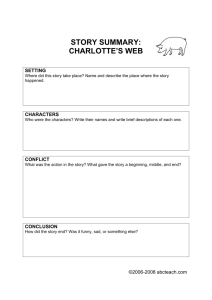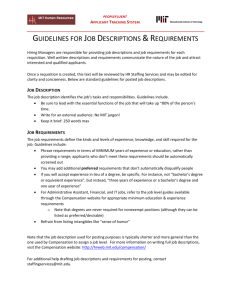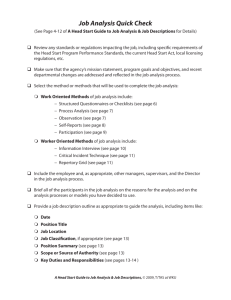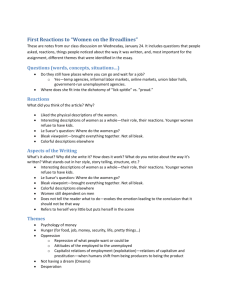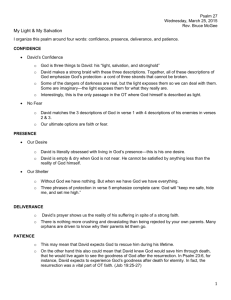Job Descriptions
advertisement
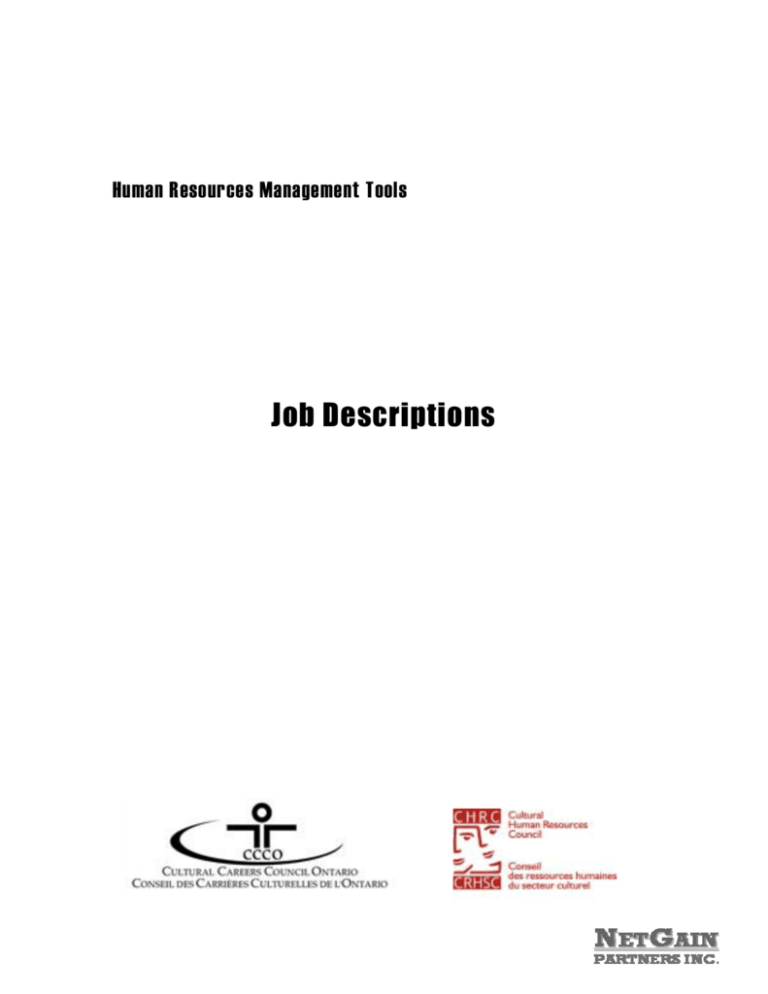
Human Resources Management Tools Job Descriptions Acknowledgements Acknowledgements Acknowledgements This module is one of six developed as part of a project involving the production of human resources management tools for use in the cultural sector. A second project involved the production of a report on Best Practices in human resources management in the cultural sector. Partners Funds for these projects were made available through the Cultural Careers Council Ontario and the Cultural Human Resources Council. The projects were carried out in partnership with the Ontario Museum Association, Directors Guild of Canada – Ontario, and Professional Association of Canadian Theatres. The partners gratefully acknowledge the contribution of the following individuals who were involved in one or both of the projects. Steering Committee Susan Annis, Executive Director, Cultural Human Resources Council Bob Johnston, Executive Director, Cultural Careers Council of Ontario Susan Cohen, Program Manager, Human Resources Initiatives Program Marcus Handman, Executive Director, Directors Guild of Canada - Ontario Marie Lalonde, Executive Director, Ontario Museum Association Lucy White, Executive Director, Professional Association of Canadian Theatres Participants Tammy Adkin, London Regional Childrens’ Museum Jeff Alexander, Vancouver Symphony David Baille, Opera Atelier Trisha Baldwin, Tafelmusik Baroque Orchestra Colleen Blake, Shaw Festival Michel Blondeau, Ecentricarts Louise Boucher, Conseil Québécois des Ressources Humaines en Culture Bill Boyle, Harbourfront Anna Bradford, City of Hamilton Mike Bregazzi, Calgary Philharmonic Dean Brinton, Foundation for Heritage and the Arts, Nova Scotia John Brotman, Ontario Arts Council Laura Brunell, American Federation of Musicians Catherine Carleton, Kitchener Waterloo Symphony Lindy Cowan, Canadian Opera Company Nancy Coy, Lorraine Kimsa Theatre for Young People Mary Crampton, Canadian Broadcasting Corporation David Devan, Pacific Opera Company Dan Donaldson, Orchestras Canada Michael Duschene, Consultant Rémi Garon, Théâtre du Nouveau Monde Dennis Garreck, SaskCulture Margaret Genovese, Genovese Vanderhoof & Associates Diane Gibbs, Shaw Festival Mallory Gilbert, Tarragon Theatre Jenny Ginder, Consultant Jocelyn Harvey, Canada Council for the Arts John Hobday, Canada Council for the Arts Claire Hopkinson, Tapestry New Opera Works Sarah Iley, Council for Business and the Arts in Canada Ian Kerr-Wilson, Hamilton Museum of Steam & Technology Lise Labine-Dugal, Canada Council for the Arts Micheline Lesage, Canada Council for the Arts Doreen Malone, Neptune Theatre Chris McDonald, Hot Docs Micheline McKay, Opera Canada Christine Moynihan, Dance Umbrella of Ontario Terry Reid, National Ballet School Gie Roberts, Alberta Theatre Projects Bob Sirman, National Ballet School Mona Skuterud, National Arts Centre Cathy Smalley, Metcalf Foundation Shelley Stevenson, Stratford Festival Jini Stolk, Creative Trust Denis Thompson, Canadian Heritage Consultants Clark Reed and his associates at Netgain Partners Inc. NetGain Partners is a team of management, development and human resources specialists committed to helping cultural, other not-for-profit and public organizations reach their immediate and long-term goals. Thanks These projects made possible by support from Table of Contents Why Are Job Description Useful__________________________ 5 Potential Problems ____________________________________ 7 Writing a Job Description _______________________________ 9 Summary ___________________________________________13 Appendix !: Action Verbs _______________________________14 Appendix II: Sample Job Description Form _________________15 Appendix III: “Purpose of Job” Statement __________________20 Appendix IV: Sample Primary/Secondary Responsibilities Statements: Technical Director _______________________________ 21 Director of Marketing and Audience Development ______ 22 Planned Giving Officer ___________________________ 23 Corporate Development Manager __________________ 24 Office Administrator _____________________________ 25 Volunteer Coordinator ___________________________ 26 Box Office Assistant ____________________________ 27 Archives Assistant ______________________________ 28 _______________________ _____________ Job Descriptions 4 Why Are Job Descriptions Useful? Why Are Job Descriptions Useful? Although most cultural organizations have job descriptions, some smaller ones do not. It’s just not a priority for them and they feel that everyone knows what they’re supposed to be doing. But regardless of the size of your organization or your cultural sub-sector, it pays to have a clear, definitive, written description of the content of each person’s position. Effectively developed, the job description is a communication tool that can contribute significantly to your organization’s success in terms of giving people a clear focus and helping them to set priorities. A poorly written job description on the other hand leads to role ambiguity, complicates communication, and can make your staff feel that they don’t know what’s expected of them. A job description is a written statement of the duties, responsibilities, required qualifications, and reporting relationships of a particular job. It’s based on information obtained through analyzing the job, an understanding of the competencies and skills required to accomplish needed tasks, and the needs of your organization to get things done. The job description clearly identifies and spells out the responsibilities of a specific job. Where relevant, it also includes information about working conditions, physical demands, knowledge and skills needed, and relationships with other positions. Still unsure about the value of job descriptions? Here are more benefits: ► Job descriptions give you an opportunity to clearly communicate your organization’s direction and where your staff fit into the “big picture”. Job descriptions not only enable your employees to assess the relative importance of everything they’re responsible for, but also give a sense of where their jobs fit into the organization as a whole. Whether you’re a small, local museum or a major national theatre company, well-written job descriptions help crystallize the organization structure for your employees. They will help you to align their activities with your goals, vision, and mission. They also clarify the interrelationship between roles – where one person’s job stops and another one starts. Job Descriptions 5 ► Job descriptions lay out clearly what you expect from people. Very often this is the first place to look if people get the feeling that they aren’t doing what you want them to do. You need to make certain that they clearly understand your expectations and this understanding starts with the job description. ► Job descriptions help you cover all your legal bases. You’ll want to make sure your job descriptions are accurate, complete and up-to-date in case you are ever involved in a legal dispute over someone’s job (e.g. an employee who has been terminated, feels it was unjust, is angry and takes legal action). ► Whether you’re recruiting new people or promoting from within, the job description tells candidates exactly what you want in the new person. A clear job description can help you select your preferred candidate, and if necessary, respond to issues and questions raised by individuals who were not selected. ► A well-written job description helps other staff, who will be working with the person hired, understand the scope and limits of the person’s responsibilities. Staff who have been involved in the hiring process are more likely to support the success of the new employee or promoted co-worker. Involving them in developing or vetting job descriptions is an easy way to help them contribute to the success of the new hire. Job Descriptions 6 Potential Problems Potential Problems In spite of those benefits described above, given the pace and work demands of most cultural organizations and the multi-tasking that is so much a part of cultural work, job descriptions can slow you down. Unless well-managed, they can interfere with your progress and put people back into the organizational chart boxes you’ve been asking them to break out of for years. They can, unless well-written, provide a refuge for staff whose commitment is limited and who aren’t interested in multi-tasking. Some organizations have job description processes that create barriers and bottle-necks in the effort of acquiring and assimilating new talent into an organization quickly. Job descriptions do your organization no good when the whole process becomes a horrendous challenge to produce and maintain, especially when the organization fails to actively use job descriptions to positively impact employee performance. Here are key points to help you avoid the most common problems with job descriptions: ► Be aware that job descriptions become dated as soon as you write them, especially in fast-paced, changing, responsive cultural environments. You need to supplement job descriptions with regularly discussed goals and development activities, at a minimum annually, preferably twice-annually. This means meeting with each of your staff or your team to ensure that their focus and priorities are in line with current initiatives in the organization. And, of course, these initiatives change frequently. This meeting has to be realistic. If your employee continually gets new tasks assigned as new projects open up, and yet is still responsible for every task in their original job description, they might be resentful – and their complaint could well be legitimate. Look at where you really want the individual to be spending their time. If the job description gives the wrong picture, change the job description. ► Make sure the job description doesn’t restrict flexibility. The job description has to be flexible so that people are comfortable cross-training, getting involved outside their normal work area (e.g. especially relevant for arts organizations that have “seasons” at which time work demands can be particularly varied and intense) and Job Descriptions 7 confident they can make appropriate decisions. Cultural managers need staff who are comfortable taking reasonable chances, are willing to multi-task and stretch their limits. You don’t want to encourage an environment where your staff withdraw from a vital task, thinking “That’s not my job”. ► Poorly-written or out-dated job descriptions can be used as evidence of wrong-doing or wrong-telling in a wrongful termination lawsuit. Avoid this managerial disaster by ensuring that job descriptions are accurate, specific and complete. ► A job description that sits filed and unused in a drawer is a waste of time. Job descriptions must be an integral part of your hiring and performance management processes. Use them to get employee ownership and support for their position and to recognize the parameters of the skills and abilities you need for the position. In hiring, the well-written job description can help you make the right selection decisions. And hiring the right team is of course critical to your future success. Your goal? A job description that gives the positive impacts described earlier, without the potential negatives described above. You can create the balance that allows the job description to inform, communicate, and align performance without damaging the speed, flexibility, and forward-looking attitude you need to make your cultural organization a success. Recognize that job descriptions are a vital part of an effective performance management system. Job Descriptions 8 Writing a Job Description Writing a Job Description There is no one best format for job descriptions. There are many different, good formats, depending on the size and complexity of an organization. Whatever format you choose, the fundamental features and qualities of a good job description are the same, and there is the same potential for producing a poorly-written job description Appendix II shows a sample template that we will use for describing the desirable features and qualities of a job description, and for helping you to write one. The template we will use has 10 potential sections (see note below): ► Title and Reporting Relationships ► Purpose of Job ► Primary Responsibilities ► Secondary Responsibilities ► Supervisory Responsibilities ► Financial Responsibilities ► Interaction with Patrons and Public ► Physical Demands ► Working Conditions and Environment ► Knowledge and Skills Required NOTE Very few organizations will need to incorporate all these sections into all their job descriptions. For example, where a position has no supervisory responsibilities, or no professional dealings with people outside the office, or no exceptional physical demands made on them, you may choose to leave these sections out. Use this template and its sections as a guideline only. You will need to consider each part and decide which items are most relevant and useful for your organization, and then customize it to your needs. Job Descriptions 9 Following are guidelines for completing these sections: 1. Title and Reporting Relationships The job title, department, the position to which it reports, and the positions that report directly to it. 2. Purpose of Job This should be a fairly brief section that gives a “thumbnail sketch” of the position, in one to four sentences. Particularly useful for including in job advertisements. It usually includes: ► an overview of the main responsibilities of the position ► the degree of supervision/management received ► the degree of supervision/management of others 3. Primary Responsibilities This is the key (and most difficult to write) section which describes the essential responsibilities of the position. It’s particularly hard to write “from scratch” when you have little or no job activities in writing. This can be the case in small and new cultural organizations, and is usually the case for newly-created positions. Key preparation tips: ► If you’re originating a new job description, here are some suggestions: • Note down in a totally random way all of the aspects of the job. Think about work processes, planning, executing, reporting, communicating, working with others, resources, money, information, inputs/outputs, etc. • Combine and develop the random collection tasks into a set of 5-15 key responsibilities. • Rank them roughly in order of importance. • Double-check that everything on the list is genuinely important and achievable, and that nothing has been left out. ► You should have 5-15 primary responsibilities, depending on the complexity/seniority of the job. ► Start each sentence with an action verb (e.g. develops, maintains, compiles, coordinates). See Appendix I for a list Job Descriptions 10 of suggested action verbs that descriptions. work well in job ► Avoid vague terms such as “helps with”, “is responsible for” in statements of Primary Responsibilities (although “is responsible for” is acceptable if used as an overview statement in the Purpose of Job section). ► Include details of decisions the job holder is expected to make, and levels of authority over staff and financial matters. ► Keep sentence structure as simple as possible. Leave out unnecessary words that don’t provide specific information. ► Do not put goals or objectives on a job description. They change through the year depending on current priorities and projects. 4. Secondary Responsibilities These are non-essential and/or infrequent activities that, if carried out by someone else, would not affect the essence of the position. The same guidelines as in Section 3 apply. 5. Staff Supervisory/Management Responsibilities Include the number and titles of staff, and if necessary for clarity, a very brief statement (one sentence) of the responsibilities of those staff roles. Also include details of staff over whom this position has partial or occasional supervisory/managerial authority. 6. Financial Responsibilities Indicate any budget responsibility (including signing authority), and activities related to accounting, bookkeeping, investments, banking, etc. 7. Interaction with Patrons and Public List the types of external individuals and organizations with which the person has contact, and the frequency/type of contact (e.g. phone, in person, written). Include, as applicable, other cultural organizations, patrons, general public, funders, associations, etc. Job Descriptions 11 8. Physical Demands Include only those physical requirements that are essential to the job and that require unusual effort (i.e. anything outside a normal office environment). These may include: lifting heavy equipment, working on elevated catwalks, working on complex film or theatre sets, close contact with high-voltage electrical equipment, climbing book/record cases, etc. 9. Working Conditions and Environment Use this section to describe anything unusual about work schedules/hours or terms of employment. This could include regular or frequent evening and weekend work, considerable travel, outdoor work, particularly hazardous work environments, etc. 10. Knowledge and Skills Required This section should describe the specific knowledge, skills and abilities that are required to perform the various functions of the position. They should be stated as the minimum requirements and should include any physical abilities required to perform the activities as detailed in the “Physical Demands” section above. The “Purpose of Job” and “Primary (or Secondary) Responsibilities” are usually regarded as the most difficult sections to write in a job description. Appendix II shows sample content for the “Purpose of Job” section for a number of cultural positions. Appendix III shows sample statements that could be included in the “Primary Responsibilities” or “Secondary Responsibilities” sections for several cultural positions. The examples given in the Appendices are not intended to be comprehensive in terms of providing input for all your job descriptions, nor to be applicable to all types of organizations in the cultural sector. They are there to show you good components of job descriptions for a range of different positions in the broad cultural community. However many of the statements may be easily adapted and customized for job descriptions in your organization. Job Descriptions 12 Summary Summary As we have stressed throughout this module, just going through the process of writing clear job descriptions for all your staff is not enough. They need to be regarded as an important, dynamic management tool, and used effectively – updated regularly, changed when organizational needs change, be a central focus for any recruiting activity. Otherwise your initial effort and commitment to this task – and very few people really get a kick out of writing job descriptions – will probably have been a waste of time. Job Descriptions 13 Action Verbs Appendix I Appendix I: Action Verbs Begin your statements of responsibilities with action verbs like these: A adapts administers advises analyzes applies approves arranges assigns audits B budgets builds C calculates coaches combines communicates compiles conducts consolidates constructs consults control corrects counsels creates D delegates delivers demonstrates designs develops devises directs E edits eliminates engineers ensures establishes estimates evaluates executes expands expedites F forecasts G generates guides H heads hires I identifies illustrates implements improves informs initiates inspects inspires installs instructs integrates interprets interviews introduces investigates J joins L launches leads locates M manages markets maximizes mediates minimizes monitors motivates N negotiates O originates obtains operates orders organizes P plans prepares presents prevents produces programs promotes protects provides publishes purchases R reorganizes repairs researches resolves restores retrieves revises receives recommends recognizes recovers recruited reduces S saves schedules secures serves simplifies sells solves stimulates streamlines summarizes supervises supports T teaches trains translates U upgrades V verifies Job Descriptions 14 Sample Job Description Form Appendix II Appendix II: Samp le Job Descrip tion Form Job Description Form Job Title: Reports to: Reporting Staff: 1. PURPOSE OF THE JOB (What are the major objectives of this position? Why does the job exist?) 2. PRIMARY RESPONSIBILITIES (The essential duties of the position.) Job Descriptions 15 Sample Job Description Form Appendix II 3. SECONDARY RESPONSIBILITIES (Responsibilities/important duties performed occasionally or in addition to the essential duties of the position.) 4. STAFF SUPERVISORY/MANAGEMENT RESPONSIBILITIES (Provide the number and type of employee managed.) Job Descriptions 16 Sample Job Description Form Appendix II 5. FINANCIAL RESPONSIBILITY (Budgeting and accounting responsibilities, reporting and auditing functions.) 6. INTERACTION WITH PATRONS AND PUBLIC Job Descriptions 17 Sample Job Description Form Appendix II 7. PHYSICAL DEMANDS (i.e. walking, lifting, equipment operation, etc.) 8. WORKING CONDITIONS AND ENVIRONMENT (i.e. necessary travel, unusual work hours, unusual environmental conditions, etc.) Job Descriptions 18 Sample Job Description Form Appendix II 9. KNOWLEDGE AND SKILLS REQUIRED (Indicate which are required, preferred, or desirable. Include licenses and certificates.) Job Descriptions 19 Sample “Purpose of Job” Statements Appendix III Appendix III: Sample “ Purpose of Job” Statements Major and Planned Gifts Manager Reporting to the Head of Marketing and Development, the Major and Planned Gifts Manager obtains funds in the form of major and planned gifts for the Endowment Fund and Benefactor Circle annual campaigns and supports the management of capital assets in the [Organization’s] foundation. Marketing and Outreach Manager Reporting to the General Manager, the Marketing and Outreach Manager is responsible for fostering audience development at a grass roots level through community outreach and education programs. Wardrobe Supervisor Reporting to the production Manager, the Wardrobe Supervisor prepares and manages the preparation of professionally-made, appropriate and attractive costumes for ballet students for ballet school productions, and maintains and ensures the security of the school’s wardrobe. Volunteer Coordinator The Volunteer Coordinator reports to the Operations Manager, administers and develop the festival’s volunteer program. This includes: 1) Conducting a volunteer needs assessment with all festival departments; 2) Recruiting, advertising for and selecting volunteers; 3) Developing an electronic database of volunteers; 4) Developing information and best conduct manuals for both staff and volunteers; 5) Scheduling volunteers into shifts for festival activities. Artistic Director The Artistic Director carries the overall responsibility of setting the artistic direction and programming of the company, and in the selection of all artistic staff to fulfill this direction. In conjunction with the Executive Director, the Artistic Director is responsible to the Board of Governors for the execution of all artistic activities of the company. Job Descriptions 20 Sample “Primary/Secondary Responsibilities” Statements Appendix IV Appendix I V: Sample “ Primary/Secondary Responsibilities” Statements T ECHNI CAL D I RECTOR ► In collaboration with and as delegated by the Director of Production, serves as Technical Director for the theatre. ► Advises on production schedules and budgets. ► Provides cost estimates on designs submitted and account for commitments and expenditures in budgets for materials and labour in scenic, stage, lighting, sound and special effects, capital equipment and other special projects. ► Establishes technical schedules and coordinate all activities related to theatre productions including scenery construction, property construction, painting, maintenance and improvements. ► Develops equipment and procedures for stage effects and changeovers. Coordinates changes and alterations to scenic stage effects as requested by the Directors, Designers and Stage Crews. Ensures the repair and maintenance of production elements as necessary. ► Coordinates and oversees the installation, maintenance and inventory of theatre technical equipment and facilities. ► Advises on, and where applicable, executes technical department capital expenditures related to production areas. ► In cooperation with other Technical Directors, coordinates the work of the Electronics Technologist with related departments, including the maintenance of lighting control, sound, and video and projection equipment. ► Adheres to, implements and enforces the theatre’s Health and Safety Policy and Procedures guidelines. Informs the Director of Production of any condition observed to be unsafe. Job Descriptions 21 Sample “Primary/Secondary Responsibilities” Statements Appendix IV D I RECTOR OF M AR KETI NG AND A UDI ENCE D EVELOPMENT ► Develops marketing and audience development plans in consultation with the Marketing and Audience Development Committee of the Board of Governors, Executive Director and Artistic Director, with contributions from the staff. Sets revenue and expense targets for box office, membership, and corporate sponsorship. Devises goals for communication activities and customer service. ► Formally reports to the Audience Development Committee of the Board of Governors on a quarterly basis and to the full Board as requested, and provides staff leadership on special task forces. ► Contributes to planning and future direction of the organization, in tandem with the senior staff team. ► Analyzes sales and contribution trends, patron feedback and competitive activity, and shares findings with senior staff, Board and marketing and audience development staff on a regular basis. ► Develops and manages budgets for the Marketing and Audience Development departments. ► Sets pricing for all productions, lectures, readings and special events. Sets discounts and premium pricing policies. ► Recruits, hires and directs contribution of advertising agency and public relations agency. ► Provides direct guidance to the Marketing and Audience Development staff in the execution of the department activities, including sales, Membership, communication, special events, customer service, advertising, publications, corporate fundraising, and media relations. ► Identifies marketing and audience development innovations, and provides leadership and direction in implementing these innovations, which include projects such as pursuing new government streams of funding and the introduction of new box office software. Job Descriptions 22 Sample “Primary/Secondary Responsibilities” Statements Appendix IV P LANNED G I VI NG O FFI CER ► Meets personally with planned gift prospects, confirmed donors, and their advisors as required and as much as possible. ► Develops and implements a comprehensive plan for the marketing of planned gifts, including the development of information resource materials, approaches for contracting donor target groups, approaches for contacting allied professionals, etc. ► Develops and implements a donor relations and stewardship program for the planned giving portfolio. ► Develops detailed acceptance policies, procedures, and protocols for the various types of planned giving vehicles. ► Establishes procedures for the tracking and qualifying of planned gift/major gift prospects and supports these procedures through careful record keeping. ► Prepares written outlines of proposed gifts and prepares financial illustrations as required. ► Keeps informed about the development field generally, and especially the tax aspects of charitable gifts and new legislation and revenue rulings affecting such gifts, both in the Canadian and American sectors. ► Writes articles and other information and marketing materials as required on planned gift opportunities for company publications. ► Organizes and helps conduct training and information seminars for prospective donors, professional financial and estate planners, and other constituencies as required. ► Represents the company in a dignified and professional manner in all donor related activities. This includes attending Opening Night performances, fundraising events, and other company functions as required. Job Descriptions 23 Sample “Primary/Secondary Responsibilities” Statements Appendix IV C ORPORATE D EVEL OPMENT M ANAGER ► Ensures that the organization is raising the funds and in-kind services it requires to meet its strategic goals as identified in its Annual Plan. ► Researches and develops new private sector funding opportunities. ► Works with Executive Director to develop revenue projections for the year. ► Oversees and executes the renewal of existing private sector partners. ► Maintains year-round communications with funders, including written reports, funder surveys and in-person meetings. ► Prepares, presents and fulfills comprehensive and tailored sponsorship recognition/benefits. ► Works within budget and secures donated goods, services and funds wherever possible. ► Maintains and fulfills an accurate list of funder benefits. ► Oversees program book ad sales and administration. ► Oversees print advertising campaign during the summer and fall months, and shares information with Communications Manager. ► Investigates the potential to undertake a special fundraising event in the off season. ► Tracks and reconciles accounts receivable. ► Writes final report detailing recommendations for enhancing the development office activities for the following year’s season. Job Descriptions 24 Sample “Primary/Secondary Responsibilities” Statements Appendix IV O FFI CE A DMI NI STRATOR Financial/Administrative ► Administers and records all incoming invoices and outgoing payments. Deals with vendor inquiries and payment requests. Recommends payments based on cash flow and payment requirements. Administers weekly payroll and ensures prompt and accurate reporting to all government agencies for all withholding and government taxes, source deductions and other items. ► Prepares bank deposits and physically makes the deposits. ► Maintains the financial reporting system and completes monthly reports as required by the General Manager. ► Oversees and manages the day to day operations of the computer system including the regular back up of data. ► Assists the General Manager in contracting of artists and facility rentals. Event Coordination ► Provides support to ad hoc committees as they may be struck for individual event planning and preparation. ► Coordinates patron events, receptions and parties including opening nights. Office Management ► Ensures the safe and adequate operation of all office equipment including liaison with service departments. ► Accounts for all office supplies and maintaining stocks. ► Investigates and recommend new equipment systems for a smoother running office environment (postal machine, photocopier, phone system etc.) ► Supervises office staff, administrative volunteers and co-op students. Production ► Liaises with the Theatre Box Office, Front of House Manager and Event Coordinator. Job Descriptions 25 Sample “Primary/Secondary Responsibilities” Statements ► Appendix IV Facilitates ticket bookings for sponsors, patrons, artists, groups and others as may be required. V OLUNT EER C OORDI NATOR ► Works with company department heads to develop a comprehensive volunteer needs assessment for company activities. ► Development and implementation of an electronic database system that tracks volunteers, and records skills, performance, and availability. ► Recruits volunteers through advertising in local media and web. ► Contacts educational institutes and other non-profit groups for assistance in recruiting new volunteers. ► Works with Operations Manager to develop a system of volunteer benefits. ► Works with Development Manager and Executive Director, as necessary, to help with sponsorship of the volunteer program. ► Ensures company staff communicate volunteer needs in due time, and provides feedback and review of volunteer performance post facto. ► Develops a volunteer manual for internal use that provides information and guidelines for staff. ► Develops a volunteer manual for volunteer use that provides company information, scheduling procedures, and helpful hints. ► Schedules volunteers into shift work for company activities, based on departmental needs and organizational priorities. ► Contacts volunteers to confirm their shifts’ start and end times. ► Works to keep volunteers properly informed about the company and their duties, through orientation meetings, group sessions, manuals, emails and phone calls. ► Works to find volunteers for special company assignments, and administers honorariums where appropriate. Job Descriptions 26 Sample “Primary/Secondary Responsibilities” Statements ► Appendix IV Prepares a Final Report detailing activities and recommendations with respect to the volunteer program. B OX O FFI CE A SSI STANT Subscriptions ► Processes phone, fax and mail orders in a timely manner. ► Captures accurate data for all subscribers including full names, addresses, phone numbers and marketing source codes. ► Assists with daily bank deposits, end-of-day reports and depositing monies at our bank. Single Ticket Sales ► Answers incoming Box Office calls for ticket orders and general inquiries. ► Captures accurate marketing data - names, addresses, and source codes. ► Handles ticket exchanges and returns. ► Assists in solving complaints, upholding the company’s reputation for excellent customer service. Other Responsibilities ► Handles merchandise sales at Box Office, keeps accurate records of sales and assists with monthly inventory. ► Reports any concerns or problems to Box Office Supervisor. ► Assists Box Office Supervisor as required with other Box Office work. ► Assists other departments as required (time permitting). ► Participates in staff meetings. Job Descriptions 27 Sample “Primary/Secondary Responsibilities” Statements Appendix IV A RCHI VES A SSI STANT ► Puts into effect all Archives’ policies and procedures established by the company. ► Responsible for the financial and administrative management of the Archives. ► Relates closely to the Artistic Director so that artistic staff/production personnel can take the fullest advantage of the Archives and Researcher’s services. ► With the cooperation of the Artistic Director or his designates, selects appropriate acquisitions both during and at the end of every season. ► At all times, acts in the best interest of the company by performing the duties in a manner that will protect, maintain and expand the Archives. ► Undertakes any research work for company productions required by directors, designers and other members of the staff. ► Supervises all Archival assistants and volunteers, establishing their tasks and areas of responsibility. ► Assists registered scholars and researchers, providing supervised access to archival material. ► Assists Exhibits Coordinator with curatorial work for festival lobbies, and other exhibitions at the request of the Artistic Director. Job Descriptions 28
